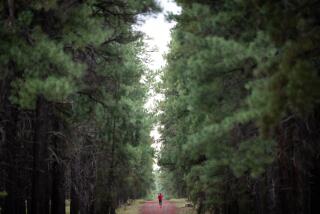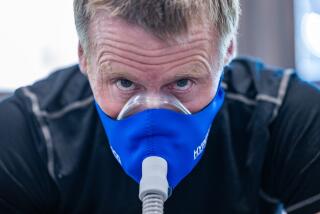The big comb-over
Leadville, Colo. — Before he can comb snow, Elliot Halverson must learn to push mud.
It’s early in the fall semester, and the Colorado Mountain College freshman sits atop an idling bulldozer in Iowa Gulch, up a long unpaved road from a valley of shuttered silver mines. Halverson studies a pickup-wide hole in the clearing that today serves as his school lab, puzzling over how to fill it.
He hesitates, then drives a bladeful of dirt into the pit. One dozer track spins briefly, spitting rocks and clods of clay into the aspens, but then grips the earth and emerges on the other side, hole filled. Later, his ski-ops professor offers encouragement: “What you were doing was good, track-packing that section.”
While Halverson, a mop-topped 20-year-old in a high school ski team sweatshirt, practices with dirt, he dreams of landing a job as a Sno-Cat driver and distributing actual “product” -- snow -- on a mountain. Some may think it sacrilege to label snow as a commodity, but in the high-stakes grab for demographically desirable skiers and snowboarders, slope grooming sells lift tickets.
To seduce the well-heeled masses, resort strategists increasingly order crews of seasoned Elliot Halversons to deliver a product they call corduroy. On more and more slopes Sno-Cat drivers smooth away any wrinkles or blemishes that might scare their best customers: jetloads of risk-averse baby boomers. This trend -- what some detractors refer to as brutal grooming -- is destroying a once revered ‘80s icon, the mogul.
Will anyone stick around to stop the brutality?
“It used to be blasphemous to say that you didn’t like skiing bumps, but today it’s OK to look down your nose at moguls,” says Mike Kessler, executive editor of Skiing magazine. “There’s definitely been a shift away from bump skiing and that whole hot-dogging mentality into the big-mountain, big-powder, free-ride realm.”
Navigating a field of moguls requires speed, superhuman quads and the bones and cartilage to withstand knee-jarring, lower-back-compressing drops from mini-hill to valley. Moguls can dislodge skis, throwing heels over heads and poles, hats and goggles flying.
“I won’t take a whole mogul run, no way,” says Betty Schlackman, president of the Dallas Ski Club. “For my level of skiing, intermediate, if I’m going to do a black [diamond], it’s got to be groomed.”
A problem with nature
It used to be that skiers got what nature offered, and the appearance of a mogul -- a mound that forms wherever skiers turn repeatedly -- was accepted as part of the experience.
Then, in 1951, Steve Bradley, mountain manager for the Winter Park ski area near Denver, began looking for a way to reduce moguls and keep snow on the trails. He came up with the Bradley Packer, a 5-foot-wide corrugated culvert that a skier would drag downhill, flattening the snow in his wake while trying to evade the spinning rotor.
“It was a pretty scary thing,” says Ron Richards, maintenance supervisor at Winter Park.
The first Sno-Cat, a tracked vehicle that towed a 20-foot-wide culvert -- a sort of bumpy pipe -- went into operation a decade later. Though grooming technology steadily improved, it wasn’t until the mid-1980s that manufacturers added blades to push snow back uphill and tillers to comb the hard pack into the silky corduroy that many skiers now expect. Around the same time, pivoting winch technology made it possible for the machines to groom uphill on steeper terrain.
“You see places groomed today that never would have been groomed 20 years ago,” says Michael Berry, president of the National Ski Areas Assn. “Everybody’s kind of exploring what’s the next steepest thing that they can groom.”
That’s because grooming is a marketing tool as much as it is a snow-moving tool: “Hail to the Sno-Cat kings ... and the most groomed terrain on the planet,” reads a Vail print ad appearing this year in ski magazines.
This year, the Colorado resort increased its overall grooming by 33%. It runs 24 Sno-Cats over two shifts, covering more than 1,000 of its 5,000 acres every night, with three hours of downtime so mechanics can service the vehicles. Breckenridge boasts that it grooms all beginner and intermediate slopes daily. Beaver Creek doubles its grooming passes and pampers its slopes with lunchtime touch-ups. The luxury Colorado ski area has also instituted guest services such as e-mailing maps to hotels that point out the day’s corduroy.
Grooming strategies vary from day to day. Areas that draw urban-close crowds comb more slopes on weekends to disperse the intermediate skiers across the mountain. Some resorts divvy the snowscape within a single run, retaining the moguls on one side so some skiers can loosen their fillings on bumps while their companions coast on the smooth.
Avid skiers notice and appreciate quality slope workmanship.
“It’s great to see a precise job done by the Cat driver,” says Dave Welz, from Durango, Colo. “Sudden variations in blade depth or sloppy transitions from one [grooming] pass to the next can make a mess of the corduroy. A lot of experienced slope groomers out there are artists with their machines.”
But some skiers and boarders have begged the ski areas to cut back on the corduroy. Intensive grooming robs the sport of its uncertainty, they say, and homogenizes the varied surfaces on which they might broaden their skills.
Winter Park -- a mecca for bumpers -- stopped grooming Drunken Frenchman, one of its signature mogul runs, after receiving a raft of complaints three years ago. And after Steamboat Springs acquired a winch Cat in the late 1980s and flattened a number of popular bump spots, one disgruntled local printed a batch of bumper stickers: “Stop the Brutal Grooming.”
“I just couldn’t understand why they’d brutally groom our best bump runs and turn them into inclined parking lots,” says Mike Farrell, who sold thousands of decals, hats and T-shirts with the admonishment. “They did it just so they could give access to people who don’t have the ability to ski that run.”
Boomers rule
If anything, however, the industry is moving toward more brutal grooming, and with good reason: Out-of-town visitors -- who bring in out-of-town money -- demand it. Aging baby boomers still dominate ticket sales, and while a new generation of wider skis has kept them riding the high-speed lifts later in life, many admit they lack the desire and stamina to carve up a steep mogul field.
“There’s not enough Nuprin that I can take in the course of the day to keep me going in the bumps,” says ski association president Berry.
And there’s probably not enough Celebrex to keep him in the terrain parks, either. The skateboarding spinoffs that have siphoned some would-be hot-doggers off mogul runs are now a commodity in their own right, particularly in Southern California. Besides making snowboarders and twin-tippers happy, they “capture” younger, rowdier riders in a relatively small space. These playpens leave other guests unmolested, and that suits trail managers just fine.
“We don’t want 500 snowboarding kids out in the middle of our ski school product, and they don’t want to be there,” says Jimmy Roberts, vice president of mountain operations at Beaver Creek.
The larger resorts now devote about 20% of their snowmaking and grooming resources to terrain parks. But ski areas close to a big snowboarding subculture, such as Southern California’s Bear Mountain and Snow Summit, have invested much more heavily in half-pipes and terrain parks littered with fun boxes and rails.
There’s even an advanced degree of sorts for groomers who specialize in terrain parks and drive Pipe Monsters and Park Bullies. They attend “Cutters Camps” -- a ski-ops graduate program of sorts -- to learn how to sculpt takeoff angles, landing zones and “progressions” that accommodate all levels of riders.
The goal, resort marketing strategists say, is to keep the product interesting. “We don’t just stamp the mountain with a package and say that’s it,” says Gary Mays, trail director at Colorado’s Breckenridge. “We try to change it throughout the year and offer diversity.”
A future in grooming
Back in Iowa Gulch, Halverson and his overwhelmingly male classmates leave the dozer and scatter.
Soon their heavy-machinery lab (the class’s core text: “Power Trains” by John Deere & Co.) will move from CMC’s Timberline campus to even higher country at Ski Cooper, a county-owned area with 26 trails over 400 acres.
By this time next year, with coursework done, they will start their “co-op,” a four-month paid position that, with the college’s 95% job placement rate, often leads to a postgrad fantasy life.
Vail grooming foreman Todd Rudis, a 1992 CMC graduate, says that after 17 years rolling up and down the mountain, he still gets a thrill out of the view from a Sno-Cat. “I love being out there at night, seeing the wildlife, the sunsets, and knowing that you’re making a difference for the next day of skiing.”
That’s what Halverson the quiet kid pictured back in his hometown of Keene, N.H., when he spotted an ad in a ski magazine for the CMC ski-operations program: “I just wanted to drive Sno-Cats and work in a ski area.”
Not to mention ski 90 days a year, play with big toys and build hits in terrain parks. People get paid for this?


